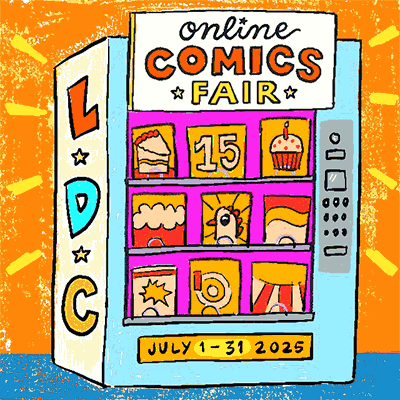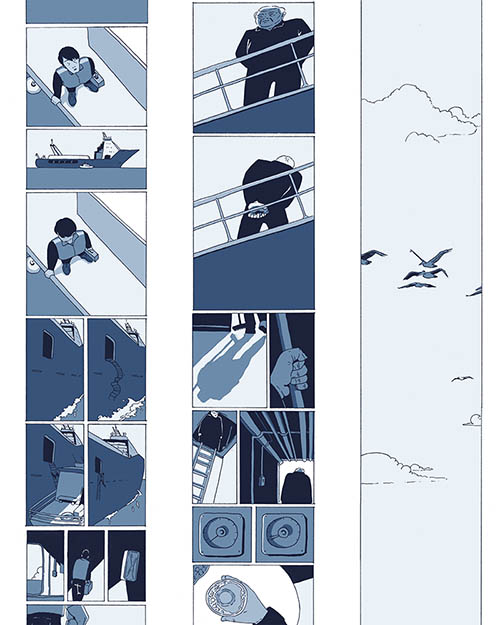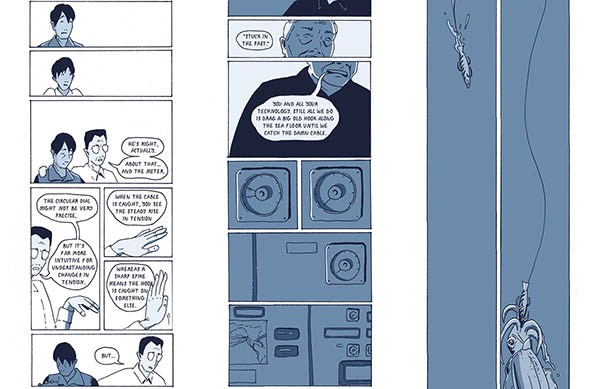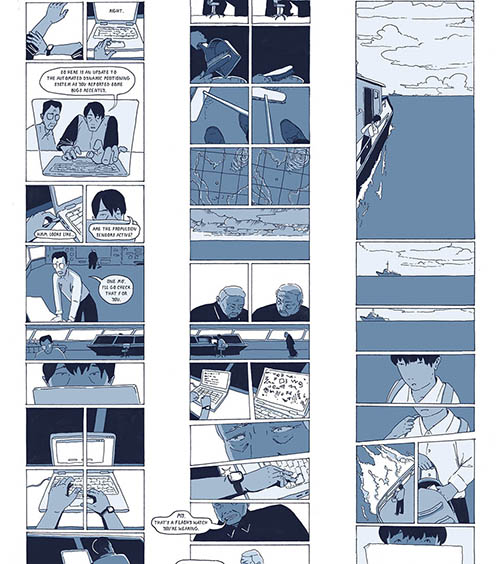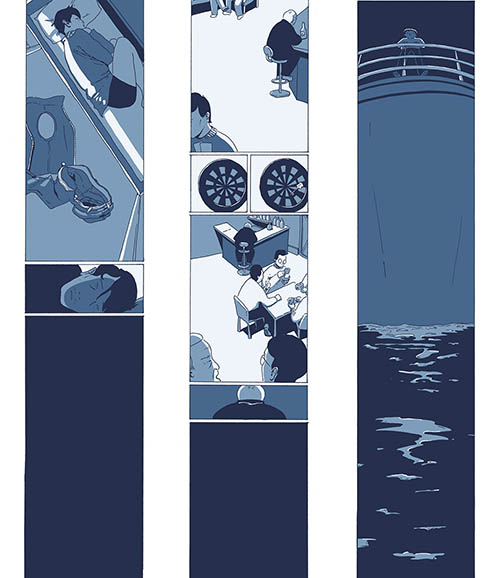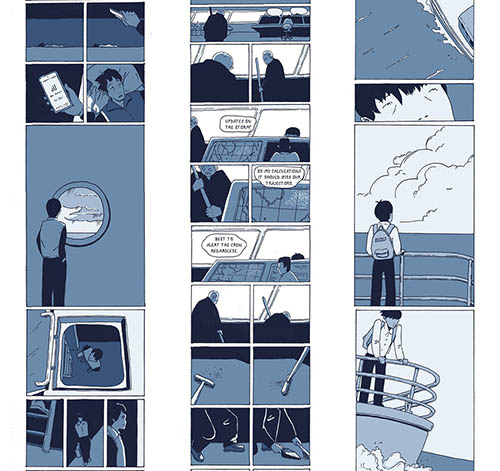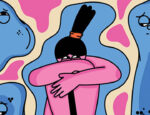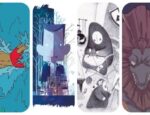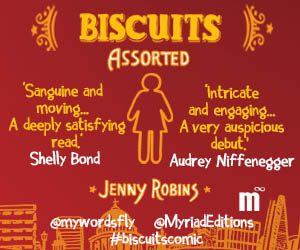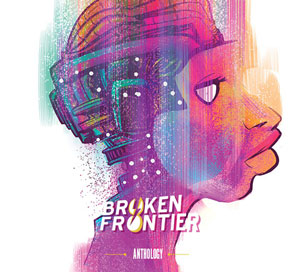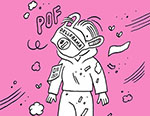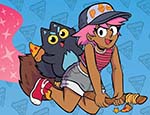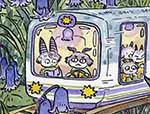LDCOMICS ONLINE COMIC FAIR 2025! Our Inside Look feature at Broken Frontier provides creators with the opportunity to share exclusive commentaries on their comics projects with our readers, giving insights into the genesis, process and themes of their work. It’s one of the oldest regular features at BF, first appearing on the site back in the mid-2000s and also one of our most well-received. Today we have a special treat for you as groundbreaking Broken Frontier ‘Six to Watch‘ creator Mereida Fajardo talks about her LDComics Online Comics Fair offering The Keluarga Cable Ship Company and adapting her process to an online format. Find out more about her work here at BF.
Cover
The Keluarga Cable Ship Company, my comic for the 2025 LDComics Fair, is my first comic designed to be read purely digitally. I’m fascinated by form and format, playing with the reading experience, which usually manifests itself in paper-folding experiments that add a physicality to my comics + zines. I love the feeling of reading, of turning the page, of holding an object in your hands; how that informs the story within, and vice versa.
It was a little terrifying therefore, embarking on this project. I applied to the fair wanting to push myself to try something new, and as with all the projects, I wanted the design of it to work intrinsically with the story inside. This being a digital comics fair, my aim was to devise a comic inextricable from its digital form, however strange and out-of-character it feels to not be printing this comic on paper.
Section 3
As the project is taking place within the digital sphere, I decided to focus the story in the subsea telecommunications cable industry. Almost all international internet communications travel via cables lying along the seabed, which are barely larger than a hosepipe.
Their installation and upkeep is a fragile, fascinating and fairly under-the-radar operation. The network is maintained by a fleet of repair ships equipped to repair the cables when they break, and for something so vital to the modern world, it’s all pretty low-tech. The repair ships use roughly the same methods as were used by the Victorians and often barely even have wifi on board themselves.
I could go on forever about these cables, but you’re here to read about comics, so I’ll spare you 🙂
Section 13
The story follows a young software engineer who boards one such ship at sea to install new software, the ship where his estranged father works as a caretaker.
The character conflict came out of this clash of old tech vs new – the father, an old seaman and navy vet, resists change and struggles to accept the march of technology, while his son, the software engineer at the cutting edge of tech, is trying to bring everything into the future but perhaps fails to see that not everything needs to be updated, some things work because they always have.
This feeds into their personal estrangement too – the father wanted his son to conform to archaic ideas of ‘being a man’ and follow his military footsteps, while the son craves the approval he never got despite his relative success as a software developer.
I’ll leave the emotional details of their relationship up to the reading experience. There was, however, a vital moment in the characters’ shared past that still colours their interactions today, and I wanted to show all these moments existing together, the past hovering over the present.
Section 10
Making a digital comic, I wanted to use the continuous scroll format and lack of page structure and page turns to its full advantage. It was really fun designing the comic downwards, and it takes place across three channels of separate but interlinked action: the son’s story, the father’s, and their shared memory.
This structure was inspired by multi-channel video installations – having several strands running simultaneously, it’s up to the viewer to decide where to focus their attention. Do you experience one at a time, or try to focus on a few or all at once? I always find myself lingering with these installations in exhibitions as they command multiple viewings where each is different, informed by what’s around and what you’ve focused on before. It’s one of those things that comics do so beautifully, that you don’t get in many other forms of storytelling – the immediacy of seeing everything on the page at once, and then the agency of choosing how to read and what to focus on.
I used the channels to convey the feeling of being trapped within your own perspective. Through communication and empathy, you can try to understand other people’s perspectives, but really you will only ever know what it feels like to be yourself. The first two channels, the son’s and the father’s, take place at the same time, and there is interaction across the gutter when they converse with each other, but ultimately each character is stuck within his own perspective. The third channel is their shared memory, and contains many echoes to their meeting in the present, while retroactively explaining some elements of their dynamic. It was fun to create visual links between the channels, while each remains its own story.
Section 21
I’m aware the structure might seem confusing at first, but I hope that as the comic goes on, it starts to make sense. I intended for the format and reading order to be somewhat freeform and mutable, and I’m really curious to hear how readers approach the comic. In theory you could read one channel at a time, or all three all at once. I kind of intended that as you read, you get sucked into one channel/perspective, and then something happening elsewhere jerks you out again, as in real life we are prone to get bogged down in our own perception until something pulls us out. It’s also something I would like readers to return to, and hope it warrants multiple readings.
Section 9
Thank you to Coral Manton at Bath Spa for the expertise on all things internet infrastructure. The Verge’s article was an invaluable resource (and a highly entertaining read), and informed many of the details of ship life. I also relied on the Global Marine website and this map of all the cables criss-crossing the world, which is well worth a look.
Blurb:
More than 99 percent of intercontinental telecommunications, including internet traffic, is carried by fibre-optic cables running along the bed of the world’s seas. Indeed, this digital comic is likely coming to you through the oceans. This vast and delicate network, the bedrock of modern life and its burgeoning technologies, is maintained by a small fleet of repair ships that keeps the world online.
Past and present collide when a software engineer arrives on one such ship, where his father works. old wounds are torn open – can this connection be repaired?
This continuous scroll comic unfolds across three separate but interlinked channels of action. The freeflow form invites readers to approach the story in different ways, separately, one by one, top down, or all at once.
40-ish pages (continuous scroll).
Article by Mereida Fajardo
The LDComics Online Comics Fair runs across the month of July. Read all our coverage of the comics on offer here at BF.
